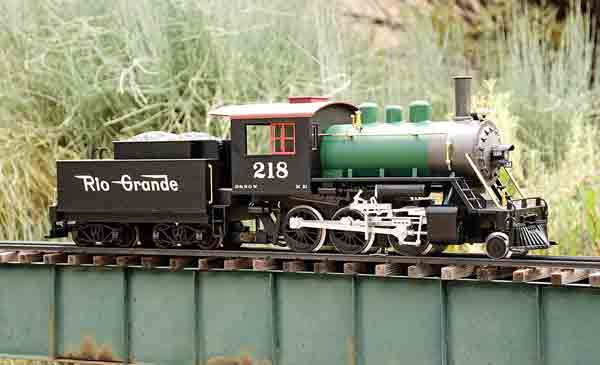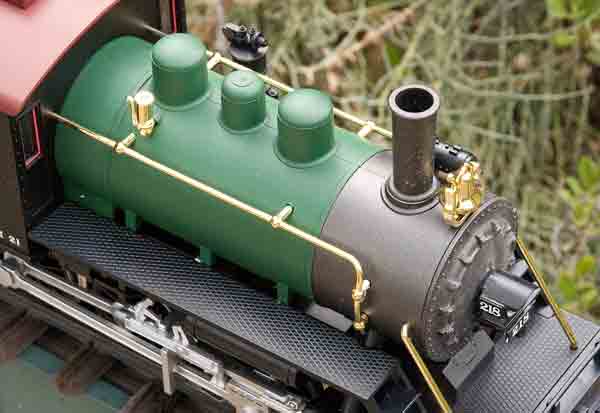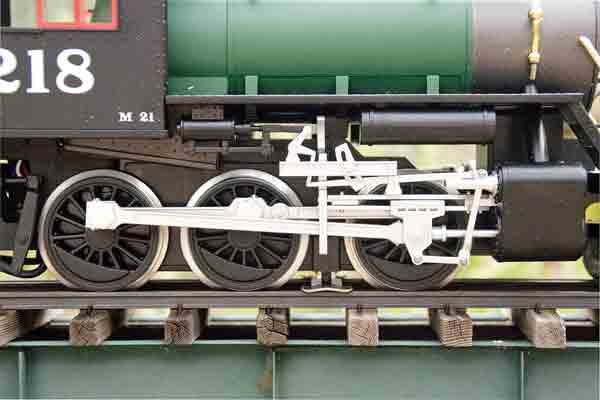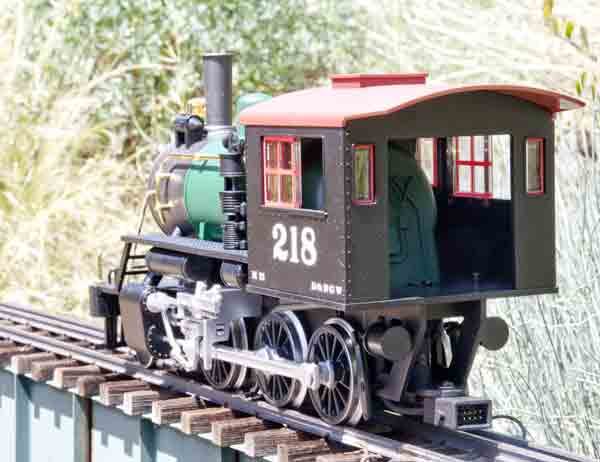Piko, Germany
Available from:
Piko America LLC
4610 Alvarado Canyon Rd., Ste. 5
San Diego CA 92120
Price: $249.99
Website: http://Piko-america.com
Mostly plastic locomotive and tender; directional LED head and backup lights; single motor; two driven axles with ball bearings; six-wheel and two slider electrical pickup; smoke generator; DCC-decoder and sound-unit ready (speaker mount provided); hook-and-loop rear coupler; engineer figure supplied; instruction booklet included; minimum radius, 24″. Dimensions: Length (locomotive and tender), 22½”; width, 4 3/16″; height. 6 3/4″. Weight (locomotive and tender), 7 lb. 1 oz.
Pros: Sturdy construction, generally; smooth operation; good paint finish and graphics; easy to couple locomotive and tender, both physically and electrically; good owner’s manual with a good set of exploded drawings
Cons: No scale specified; no front coupler; low level of detail; shiny gold detail parts
The bodies of the locomotive and tender are made of heavy plastic. The locomotive has additional weight added for traction. A smoke unit is installed in the stack and an initial supply of smoke fluid is supplied. The engine is furnished with directional lights, both a headlight on the smokebox front and a backup light on the rear of the tender. A brief but thorough owner’s manual is supplied in several languages, and I was pleased to see that it includes excellent exploded-view drawings of all sub-assemblies of the engine and tender. These make disassembly of the unit much easier.
The engine is powered by a single motor in the boiler, geared to the first and third axles. The middle drivers are powered by the side rods, which are plastic. All of the valve-gear parts are also plastic. Some of these parts move, some are stationary, and purists will notice that some are missing altogether.
Electrical pickup is through the six drivers as well as a pair of sliders between the first and second driven axles. All wheels on the locomotive have metal tires and two drivers also have traction tires. The engine’s drivers are good looking, with see-through spokes and nicely shaped counterweights.
The locomotive is set up to accept Piko’s sound and DCC units (available separately). A speaker housing is built into the bottom of the tender. The tender shell must be removed (six screws) for the installation of these parts.
A single drawbar connects the engine to the tender, both physically and electrically. This drawbar has a built-in plug, half on the locomotive side and half on the tender side. You simply slide the two halves together, then lock the drawbar with the built-in metal clip to prevent them separating under load. This is a neat system that works well. Its only drawback is in the fact that it would be pretty difficult to shorten the drawbar to bring the locomotive and tender a little closer together, though I believe it could be done if desired.
Cosmetically, the engine is pretty spartan. Several of the details, including the handrails, bell, headlight housing, brake cylinders, air pump, flag holders, pilot supports, and whistle must be applied by the purchaser. These are all press-fit parts and presented no problems. Except for the air pump, headlight, and brake cylinders, the parts are rendered in a garish, shiny-gold finish that mars the appearance of the engine and emphasizes its toy-like quality. The domes atop the boiler appear too small for an engine of this size.
There is a dummy coal load in the tender, as well as a rear ladder and four gold handrails. The tender is equipped with a pair of archbar trucks with plastic wheelsets. A hook-and-loop coupler is attached to the rear tender truck. The engine has no front coupler, nor is there provision for attaching one.
In operation, the engine runs smoothly, though it was a little noisy. Slow-speed operation is excellent and the top speed is reasonable—not too fast. At 24 volts, with drivers slipping, the engine drew less than two amps. Thanks to the locomotive’s weight and two traction tires, it has about 32 ounces of tractive effort, or enough to haul around 26 average freight cars on straight, level track. However, I did notice that on a steep down grade with a heavy train (i.e., with the train pushing the engine), the locomotive had a tendency to cog or lurch somewhat.
This locomotive is a good runner, a strong puller, and has its own kind of pug-nosed charm. It will negotiate the tightest-radius track and incorporates a useful innovation or two. Piko has produced a basic, well-made piece of machinery.

















